1996 PONTIAC PONTIAC parking brake
[x] Cancel search: parking brakePage 6 of 370
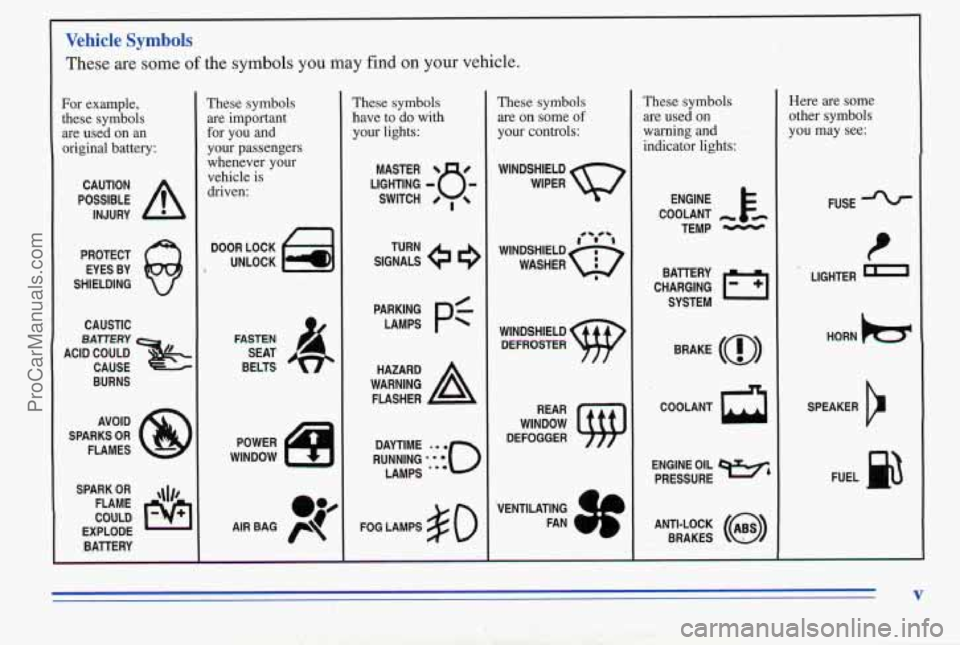
1
Vehicle Symbols
These are some of the symbols you may find on your vehicle.
For example,
these symbols are used on an
original battery:
POSSIBLE A
CAUTION
INJURY
PROTECT EYES BY
SHIELDING
CAUSTIC
ACIEEZ CAUSE
BURNS
AVOID
SPARKS
OR
FLAMES
SPARK
OR ,\I/,
COULD FLAME
EXPLODE BATTERY
These symbols
are important
for you and
your passengers
whenever your
vehicle is driven:
DOOR LOCK
UNLOCK
FASTEN SEAT
BELTS
POWER
WINDOW
c
These symbols
have to do with
your lights:
SIGNALS e 9
TURN
PARKING
PC
LAMPS
FOG LAMPS $0
These symbols
are
on some of
your controls:
WINDSHIELD
WIPER
'VENTILATING
FAN
These symbols
are used on
warning and
indicator lights:
COOLANT -
TEMP -
CHARGING 1-1
BATTERY
SYSTEM
BRAKE
(0)
COOLANT a
ENGINE OIL w,
PRESSURE
ANTI-LOCK
(@)
BRAKES
Here are some
other symbols
you may see:
FUSE
P
LIGHTER m
HORN )cr
SPEAKER
b
FUEL e3
V
ProCarManuals.com
Page 83 of 370
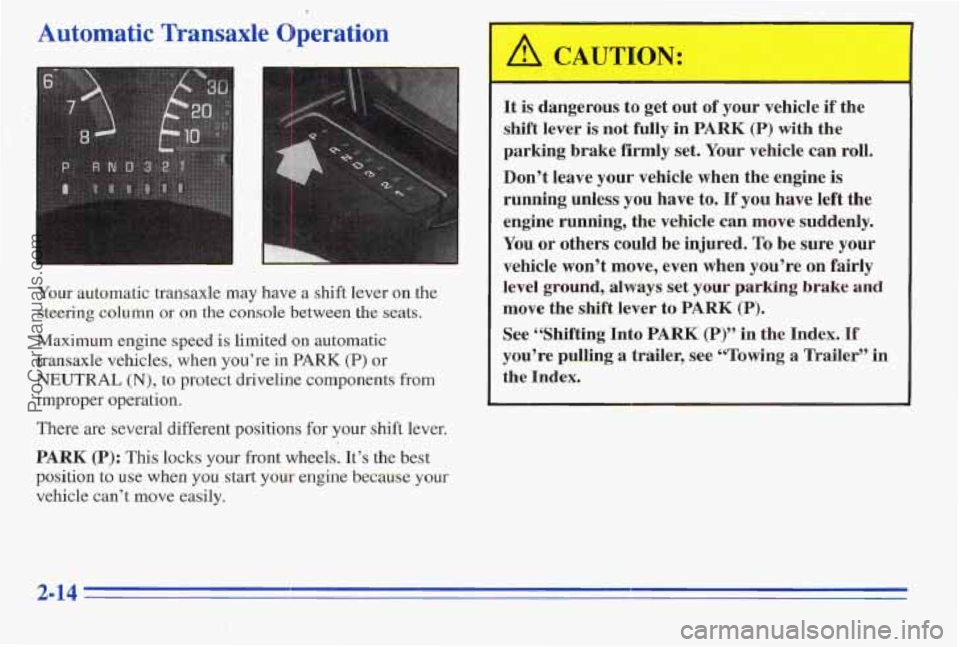
Automatic Transaxle Operation
Yom automatic transaxle may have a shift lever on the
steering
column or on the console between the seats.
Maximum engine speed is limited
on automatic
transaxle vehicles, when you’re in
PARK (P) or
NEUTRAL (N), to protect driveline components from
improper operation.
There are several different positions for your shift lever.
PARK (P): This locks your front wheels. It’s the best
position to use when you start your engine because your
vehicle can’t move easily.
/I CAUTION:
It is dangerous to get out of your vehicle if the
shift lever is not
fully in PARK (P) with the
parking brake firmly set. Your vehicle can roll.
Don’t leave
your vehicle when the engine is
running unless you have to. If you have left the
engine
running, the vehicle can move suddenly.
You or others could
be injured. To be sure your
vehicle won’t move, even when you’re on fairly
level ground,
always set your parking brake and
move the shift lever to PARK (P).
See “Shifting Into PARK (P)” in the Index. If
you’re pulling a trailer, see LCTo~ing a Trailer” in
the Index.
ProCarManuals.com
Page 87 of 370

Second-Gear Start (Option) Parking Brake
Your vehicle may
be equipped with a
second-gear start feature.
Press
2ND GEAR START
to provide more traction
when you
are starting on ice
or other slippery surfaces.
The transaxle will be in second gear when the vehicle
begins to move. After starting
in second gear, the
vehicle will upshift normally.
SECOND
GEAR START
his feature is only for
improved traction
only when
the road surface is slippery
and is not intended for
continuous use or when the
vehicle is stuck in sand, .mud,
ice, snow or gravel. Press the
switch to
turn off the feature.
Leave the switch
off for
normal road conditions.
To set the parking brake,
hold the regular
brake pedal
down
with your right foot.
Push down the parking
brake pedal with your
left foot.
To release the parking brake, hold the regular brake
pedal down with your right
foot and push the parking
brake pedal with your left foot.
When you lift your left
foot, the parking brake pedal will follow it to the
released position.
ProCarManuals.com
Page 88 of 370
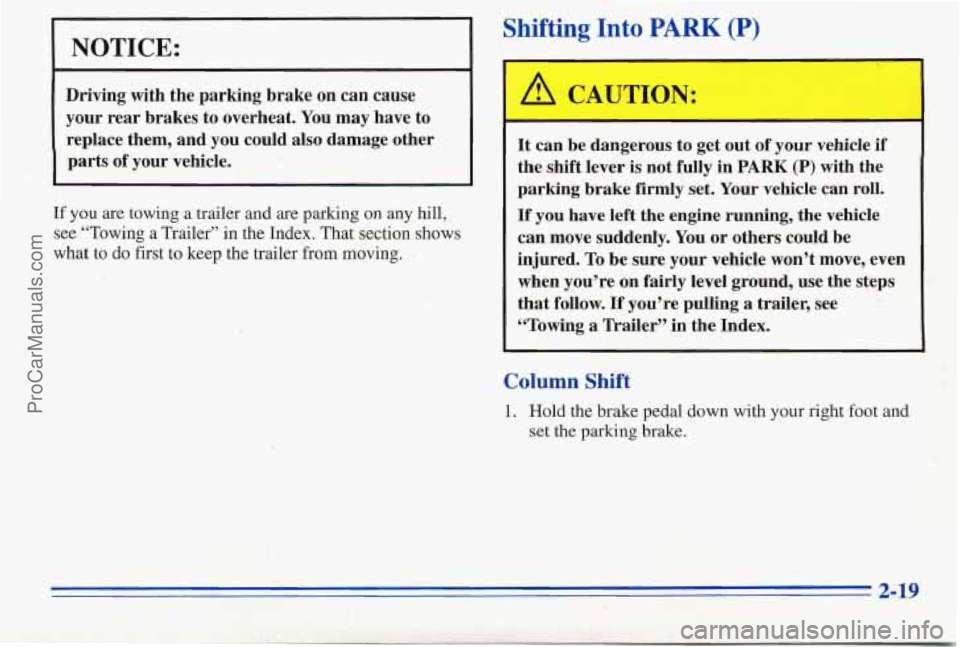
Shifting Into PARK (P)
NOTICE:
Driving with the parking brake on can cause
your rear brakes to overheat. You may have to
replace them, and you could also damage other
parts of your vehicle.
If
you are towing a trailer and are parking on any hill,
see "Towing a Trailer" in the Index. That section shows
what to do first
to keep the trailer from moving.
L
e dangerous to get out of your vehicle if
the shift. lever is not fully in
PARK (P) with the
parking brake firmly
set. Your vehicle can roll.
If you have left the engine running, the vehicle
can move suddenly.
You or others could be
injured.
TO be sure your vehicle won't move, even
when you're on
fairly level ground, use the steps
that follow.
If you're pulling a trailer, see
"Towing a Trailer'' in the Index.
Column Shift
1. Hold the brake pedal down with your right foot and
set the
parking brake.
ProCarManuals.com
Page 90 of 370
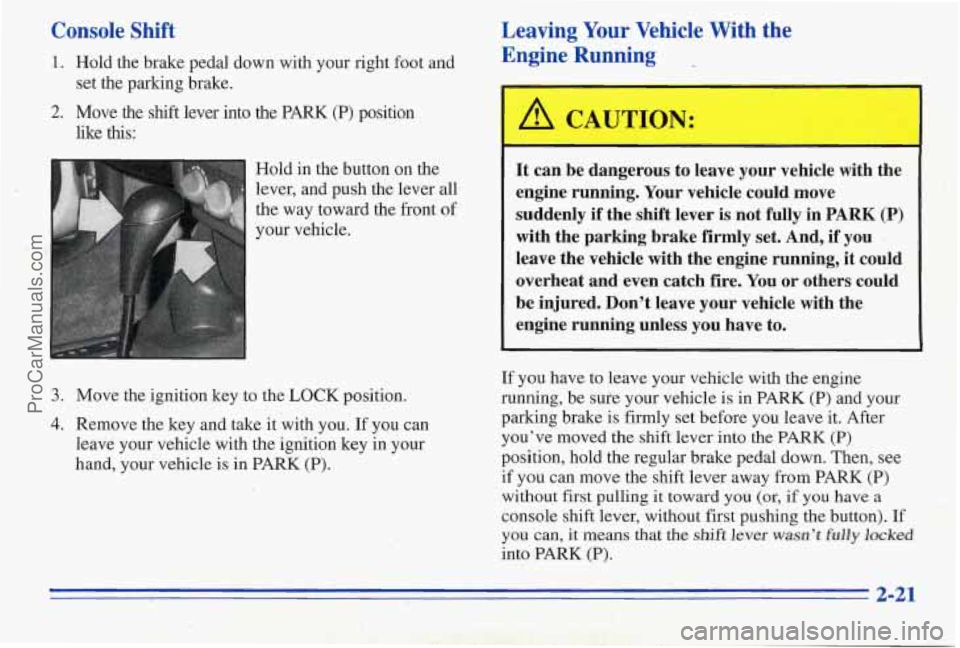
Console Shift
1. Hold the brake pedal down with your right foot and
2. Move the shift lever into the PARK (P) position
set the parking brake.
like
this:
I Hold in the button on the
lever,, and push ‘the lever
all
the way toward the front of
3. Move the ignition key to the ‘LOCK position.
4. Remove the key and take it with you. If you can
leave your vehicle with the ignition
key in your
hand, your vehicle is in PARK (P).
. /. 1 ,‘r ,*
Leaving Your Vehicle With the
Engine Running
A CAUTION:
It can be dangerous to leave your vehicle with the
engine running. Your vehicle could move
suddenly
if the shift lever is not fully in PARK (P)
with the parking brake firmly set. And, if you I
leave the vehicle with the engine running, it could
overheat and even catch fire. You or others could
be injured. Don’t leave your vehicle with the
engine running unless you have to.
If you have to leave your vehicle with the engine
running, be sure your vehicle is in PARK (P) and your
parking brake
is firmly set before you leave it. After
you’ve moved the shift lever into the PARK
(P)
position, hold the regular brake pedal down. Then, see
if you can move the shift lever away from PARK (P)
without
first pulling it toward you (or, if you have a
console shift lever, without first pushing the button). If
you can, it means that the shift lever wasn’t fully locked
into PARK (P) .
2-21
ProCarManuals.com
Page 91 of 370
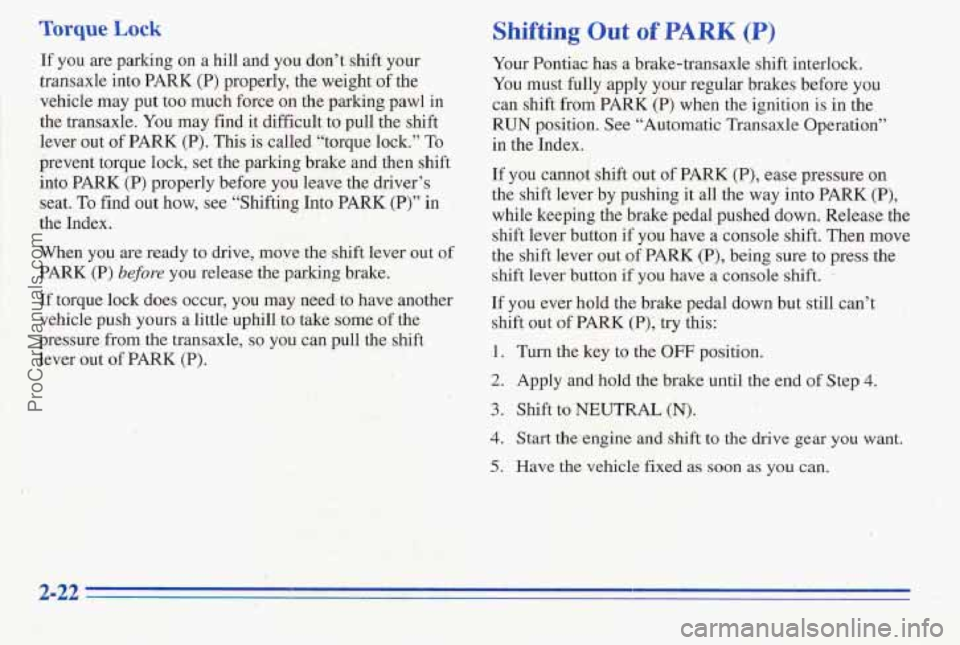
Torque Lock Shifting Out of PARK (P)
If you are parking on a hill and you don’t shift your
transaxle into PARK (P) properly, the weight of the
vehicle may put too much force on the parking pawl in
the transaxle. You may find it difficult to pull the shift
lever out
of PARK (P). This is called “torque lock.” To
prevent torque lock, set the parking brake and then shift
into PARK (P) properly before you leave the driver’s
seat.
To find out how, see “Shifting Into PARK (P)” in :.
the Index. I
When you are ready to drive, move the shift lever out of
PARK (P) before you release the parking brake.
If torque lock does occur, you may need to have another
vehicle push yours a little uphill
to take some of the
pressure
from the transaxle. so vou can pull the shift
lever out
of PARK (P).
1 .:
Your Pontiac has .a brake-transaxle shift interlock.
You must fully apply your regular brakes before you
can shift from PARK (P) when the ignition is in the
I RUN position. See “Automatic Transaxle Operation”
in the Index.
If you cannot shift out
of PARK (P), ease pressure on
, the shift lever by pushing it all the way into PARK (P),
. while keeping the brake pedal pushed down. Release the
.. . shift lever button if you have a console shift. Then move
the
shift lever out of PARK (P), being sure to press the
shift lever button
if you have a console shift. .
If y’ou ever hold the brake pedal down but still can’t
shift out of
PARK (PI; try this:
1. Turn the key to the OFF position.
2. Apply and hold the brake until the end of Step 4.
3. Shift to NEUTRAL (N).
4. Start the engine and shift to the drive gear you want.
5. Have the vehicle’ fixed as soon as you can.
ProCarManuals.com
Page 93 of 370

Running Your Engine While
You’re Parked
It’s bewr not to park with the engine ruanhig. But if you
ever have to, here are some things to know.
:- I .. .,
Idling the engine. with the air system control
off could allow dangerous exhaust into yo,ur
vehide (see the earlier Caution under
“Engine Exhalast”).
Also, idling in
a closed-in place can let deadly
carbon monoxide (CO) into your vehicle even if
the fan switch
is at the highest setting. \One place
this an happen is a garage. Exhanst -- with
CO -- can come in easily. park in a
garage with. the engine running.
Another closed-in place can be
a blizzard: (See
‘CBlizzard”
in the Index.)
It can be. dangerous to get out of your vehicle if
the shift lever is not fully in PARK (P) with the
parking brake firmly set. Your vehicle can roll.
Don’t leave your vehicle when the engine
is
running unless you have to. If you’ve left the
engine running, the vehicle can move suddenly.
You or others could be injured.
To besure your
vehicle
won’t move, even when you’re on fairly
level ground, always set your parking brake and
.move the shift lever to Pm (P).
Follow the proper steps to be sure your vehicle won’t
move. See “Shifting Into PARK (P)” in the Index.
If you are parking on a hill and if you’re pulling a
trailer, also see “Towing a Trailer” in the Index.
ProCarManuals.com
Page 102 of 370

Daytime Running Lamps (Option)
Daytime Running Lamps (DRL) can make it easier for
others to see the front
of your vehicle during the day.
DRL can be helpful in many different driving
conditions, but they can be especially helpful in the
short periods after dawn and before sunset.
A light sensor on top of the instrument panel makes the
DRL work, so be sure it isn’t covered.
The DRL system will make your low-beam headlamps
come on at a reduced brightness when:
0 The ignition is on,
0 The headlamp switch is off, and
0 The parking brake is released.
When
the DRL aye on, only your low-beam headlamps
will be on. The taillamps, sidemarker and other lamps
won’t be on.
Your instrument panel won’t be lit up either.
When it’s dark enough outside, your low-beam headlamps
will change to
full brightness. The other lamps that come
on with your headlamps will also
come on. When
it’s bright enough outside, the regular lamps will
go out, and your low-beam headlamps will change to
the reduced brightness of DRL.
To idle your vehicle with the DIU off, set the parking
brake while the ignition is in the
OFF or LOCK
position. Then start your vehicle. The DRL will stay
off until you release the parking brake.
As with any vehicle, you should turn on the regular
headlamp system when you need it.
Fog Lamps
To turn the fog lamps on, press the top of the fog lamp
switch
(C). Press the bottom of the switch to turn the fog
lamps
off. Your parking lamps must be on, or your fog
lamps won’t come on.
The fog lamps will
go off whenever you change to
high-beam headlamps. When you return to low beams,
the fog lamps will come on again.
. 2-33
ProCarManuals.com